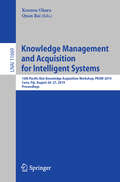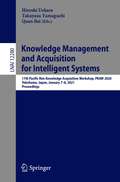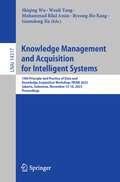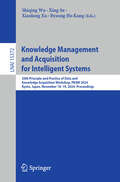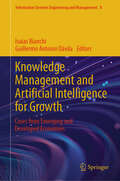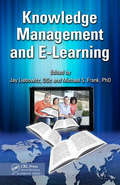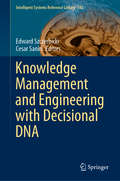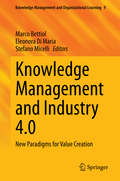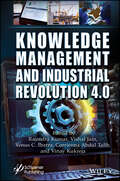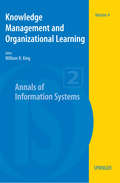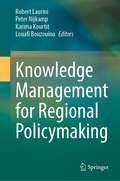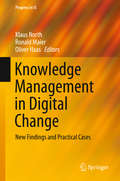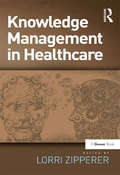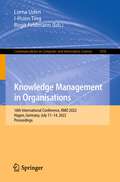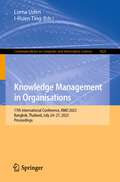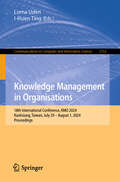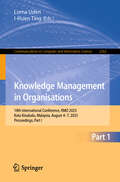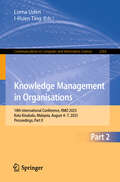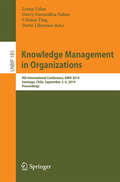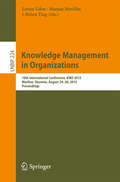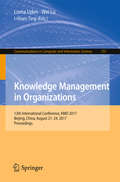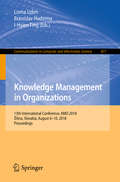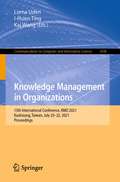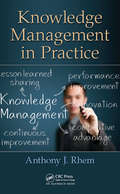- Table View
- List View
Knowledge Management and Acquisition for Intelligent Systems: 16th Pacific Rim Knowledge Acquisition Workshop, PKAW 2019, Cuvu, Fiji, August 26–27, 2019, Proceedings (Lecture Notes in Computer Science #11669)
by Quan Bai Kouzou OharaThis book constitutes the proceedings of the 16th International Workshop on Knowledge Management and Acquisition for Intelligent Systems, PKAW 2019, held in Cuvu, Fiji, in August 2019.The 9 full papers and 7 short papers included in this volume were carefully reviewed and selected from 38 initial submissions. The papers cover advanced research work that contributes to the technical and theoretical aspects in the fields of intelligent systems/agents, natural language processing, and applications of machine learning techniques including Deep Learning to real world problems.
Knowledge Management and Acquisition for Intelligent Systems: 17th Pacific Rim Knowledge Acquisition Workshop, PKAW 2020, Yokohama, Japan, January 7–8, 2021, Proceedings (Lecture Notes in Computer Science #12280)
by Quan Bai Hiroshi Uehara Takayasu YamaguchiThis book constitutes the proceedings of the 17th International Workshop on Knowledge Management and Acquisition for Intelligent Systems, PKAW 2020, held in Yokohama, Japan, in January 2021. The 10 full papers and 5 short papers included in this volume were carefully reviewed and selected from 28 initial submissions. PKAW primarily focuses on the multidisciplinary approach of the human-driven and data-driven knowledge acquisition, which is the key concept that has remained unchanged since the workshop has been established.
Knowledge Management and Acquisition for Intelligent Systems: 19th Principle and Practice of Data and Knowledge Acquisition Workshop, PKAW 2023, Jakarta, Indonesia, November 15-16, 2023, Proceedings (Lecture Notes in Computer Science #14317)
by Guandong Xu Byeong-Ho Kang Shiqing Wu Wenli Yang Muhammad Bilal AminThis book constitutes the refereed proceedings of the 19th Principle and Practice of Data and Knowledge Acquisition Workshop, PKAW 2023, held in conjunction with the 20th Pacific Rim International Conference on Artificial Intelligence (PRICAI 2023), in November 2023, in Jakarta, Indonesia. The 9 full papers and 2 short papers included in this volume were carefully reviewed and selected from 28 initial submissions. They are organized in the topical section such as machine learning, natural language processing, and intelligent systems.
Knowledge Management and Acquisition for Intelligent Systems: 20th Principle and Practice of Data and Knowledge Acquisition Workshop, PKAW 2024, Kyoto, Japan, November 18–19, 2024, Proceedings (Lecture Notes in Computer Science #15372)
by Byeong Ho Kang Xing Su Xiaolong Xu Shiqing WuThis book constitutes the refereed proceedings of the 20th International Conference on Knowledge Management and Acquisition for Intelligent Systems, PKAW 2024, held in Kyoto, Japan, during November 18–19, 2024. The 15 full papers and 9 short papers presented in this volume were carefully reviewed and selected from 52 submissions. These papers demonstrate advanced research on machine learning, natural language processing, computer vision, and intelligent systems.
Knowledge Management and Artificial Intelligence for Growth: Cases from Emerging and Developed Economies (Information Systems Engineering and Management #8)
by Isaias Bianchi Guillermo Antonio DávilaThis book delves into the intersection of Knowledge Management (KM) and Artificial Intelligence (AI). It explores their applications, challenges, and opportunities across various industries and regions. The approach is comprehensive, drawing insights from experts worldwide. The book offers fresh perspectives on using KM and AI as powerful tools for driving business success. It covers research opportunities, real-world case studies, and empirical investigations. Notably, it emphasizes the unique context of knowledge management in the southern hemisphere. The book spans a broad range of subjects, including knowledge absorption capacity as an internationalization driver, quality certification methods in the health sector, and the role of intellectual capital in Argentine tech companies. It also delves into machine learning techniques for property price estimation in Brazil and identity document verification in Peru. Professionals, scholars, and policymakers navigating the complex integration of KM and AI will find this book invaluable. By combining theoretical foundations with practical findings, it equips readers with the knowledge and tools needed for sustainable growth within their organizations.
Knowledge Management and E-Learning
by Jay Liebowitz Michael S. FrankThe rapidly growing demand for online courses and supporting technology has resulted in a plethora of structural and functional changes and challenges for universities and colleges. These changes have led many distance education providers to recognize the value of understanding the fundamental concepts of both e-learning and knowledge management (K
Knowledge Management and Engineering with Decisional DNA (Intelligent Systems Reference Library #183)
by Edward Szczerbicki Cesar SaninThis is the first book on experience-based knowledge representation and knowledge management using the unique Decisional DNA (DDNA) technology. The DDNA concept is roughly a decade old, and is rapidly attracting increasing attention and interest among researchers and practitioners. This comprehensive book provides guidelines to help readers develop experience-based tools and approaches for smart engineering of knowledge, data and information. It does not attempt to offer ultimate answers, but instead presents ideas and a number of real-world case studies to explore and exemplify the complexities and challenges of modern knowledge engineering issues. It also increases readers’ awareness of the multifaceted interdisciplinary character of such issues to enable them to consider – in different ways – developing, evaluating, and supporting smart knowledge engineering systems that use DDNA technology based on experience.
Knowledge Management and Industry 4.0: New Paradigms for Value Creation (Knowledge Management and Organizational Learning #9)
by Eleonora Di Maria Marco Bettiol Stefano MicelliThe book discusses the opportunities and challenges of managing knowledge in the new reality of Industry 4.0. Addressing paradigmatic changes in value creation due to the development of digital technologies applied to manufacturing (additive manufacturing, IoT, robotics, etc.), it includes theoretical and empirical contributions on how Industry 4.0 technologies allow firms to create and exploit knowledge. The carefully selected expert contributions highlight the potential of these technologies in acquiring knowledge from a larger number of sources and examine approaches to innovation, organization of activities, and stakeholder development in the context of this next industrial revolution.
Knowledge Management and Industry Revolution 4.0
by Rajendra Kumar Vishal Jain Vinay Kukreja Corrienna Abdul Talib Venus C. IbarraGet up to speed with how the latest knowledge management and industry 4.0 technologyhelp make enterprises secure, controlled, and optimized for a better future. This book focuses on how the practices of Industrial Revolution 4.0 and knowledge management interact to create value. In recent years, value chain relationships and related activities have utilized new technologies so that existing conceptual frameworks require a roadmap for innovation strategies and effective implementation. The chapters in this book include case studies contributed by researchers and industry practitioners that showcase the impact of practices and challenges presented by technological changes, upgrading of old systems, and internal and external factors. Knowledge Management and Industrial Revolution 4.0 describes how knowledge management impacts the automation of the industry in secure, controlled, and optimized ways. For instance, the use of the latest technologies and sensors can lead to significant time and cost savings, and operators can utilize their machines and equipment from remote locations. The Industrial Revolution 4.0 incorporates the latest technologies for automation and, in many cases, the result is similar to working from home, even in manufacturing. The use of deep learning should offer many quality control benefits. Furthermore, blockchain technology can help the industry with automation in secure and transparent ways. Apart from industry automation, other departments like human resources can also use effective knowledge management for better outcomes. The use of HR knowledge management allows employees to find and access the information they require without the assistance of the HR department. The book focuses on every aspect of the industry to help all the stakeholders of an organization. The benefits include a reduction in time required for accessing information, easier training, decreased operational expenses, improved stakeholders’ satisfaction, faster problem-solving, increased pace of innovation, simpler employee review and progress reports. Audience The book will have a wide audience within academia, education, businesses, and industrial organizations, especially those who are undergoing industry 4.0 changes to optimize for a better future.
Knowledge Management and Organizational Learning
by William R. KingKnowledge management (KM) is a set of relatively-new organizational activities that are aimed at improving knowledge, knowledge-related practices, organizational behaviors and decisions and organizational performance. KM focuses on knowledge processes--knowledge creation, acquisition, refinement, storage, transfer, sharing and utilization. These processes support organizational processes involving innovation, individual learning, collective learning and collaborative decision-making. The "intermediate outcomes" of KM are improved organizational behaviors, decisions, products, services, processes and relationships that enable the organization to improve its overall performance. Knowledge Management and Organizational Learning presents some 20 papers organized into five sections covering basic concepts of knowledge management; knowledge management issues; knowledge management applications; measurement and evaluation of knowledge management and organizational learning; and organizational learning.
Knowledge Management for Regional Policymaking
by Peter Nijkamp Karima Kourtit Robert Laurini Louafi BouzouinaThe present publication focusses the attention on new avenues in regional information and knowledge management, while we will zoom in particularly on the potential promises and hurdles of digital technology. This digital challenge has already generated a wealth of implications in the area of smart or intelligent cities, but as yet far less has been achieved in the field of regional planning and regional science. There is clearly a need for a more systematic and wide-ranging assessment and presentation of emerging approaches and concepts in this field, for instance, in regard to principles (e.g. geographic rule modeling), methodologies (e.g. blockchain systems), data analytics (e.g. machine learning) and data governance (e.g. data sovereignty) of regional information and knowledge. Especially in our ‘big data’ era, a systematic, comprehensible and reliable acquisition, storage, sharing and handling of data (e.g. on the basis of systematic decomposition and filtering principles) is more needed than ever before. The present study seeks to present a selection of state-of-the-art contributions on advanced – often digitally-oriented – regional information and knowledge management foundations, principles and practices written by several experts in the field of spatial informatics. These contributions were collected with a view to the design of a comprehensive knowledge and research agenda, which was discussed during a brainstorm workshop in Lyon, France (October 2021). This book covers various fields of interest, such as GeoAI, knowledge modelling, IoT and scalability, space syntax, rule extraction, data governance and data self-sovereignty. It is concluded with a knowledge and research agenda outlining future endeavors in the field of the spatial information sciences (or spatial informatics).
Knowledge Management in Digital Change: New Findings And Practical Cases (Progress in IS)
by Klaus North Ronald Maier Oliver HaasThis book features both cutting-edge contributions on managing knowledge in transformational contexts and a selection of real-world case studies. It analyzes how the disruptive power of digitization is becoming a major challenge for knowledge-based value creation worldwide, and subsequently examines the changes in how we manage information and knowledge, communicate, collaborate, learn and decide within and across organizations. The book highlights the opportunities provided by disruptive renewal, while also stressing the need for knowledge workers and organizations to transform governance, leadership and work organization. Emerging new business models and digitally enabled co-creation are presented as drivers that can help establish new ways of managing knowledge. In turn, a number of carefully selected and interpreted case studies provide a link to practice in organizations.
Knowledge Management in Healthcare
by Lorri ZippererKnowledge management goes beyond data and information capture in computerized health records and ordering systems; it seeks to leverage the experiences of all who interact in healthcare to enhance care delivery, teamwork, and organizational learning. Knowledge management - if envisioned thoughtfully - takes a systemic approach to implementation that includes the embodiment of a learning culture. Knowledge is then used to support that culture and the knowledge workers within it to encourage them to share what they know, thusly enabling their peers, their organizations and ultimately their patients to benefit from their experience to proactively dismantle hierarchy and encourage sharing about what works, and what doesn’t to focus efforts on improvement. Knowledge Management in Healthcare draws on relevant business, clinical and health administration literature plus the analysis of discussions with a variety of clinical, administrative, leadership, patient and information experts. The result is a book that will inform thinking on knowledge access needs to mitigate potential failures, design lasting improvements and support the sharing of what is known to enable work towards attaining high reliability. It can be used as a general tool for leaders and individuals wishing to devise and implement a knowledge-sharing culture in their institution, design innovative activities supporting transparency and communication to strengthen existing programs intended to enhance knowledge sharing behaviours and contribute to high quality, safe care.
Knowledge Management in Organisations: 16th International Conference, KMO 2022, Hagen, Germany, July 11–14, 2022, Proceedings (Communications in Computer and Information Science #1593)
by Lorna Uden I-Hsien Ting Birgit FeldmannThis book contains the refereed proceedings of the 16th International Conference on Knowledge Management in Organizations, KMO 2022, held in Hagen, Germany, in July 2022. The 24 full papers and 5 short papers accepted for KMO 2022 were selected from 61 submissions and are organized in topical sections on: knowledge transfer and sharing; knowledge and organization; knowledge and service innovation; industry 4.0; information and knowledge systems; intelligent science; AI and new trends in KM.
Knowledge Management in Organisations: 17th International Conference, KMO 2023, Bangkok, Thailand, July 24–27, 2023, Proceedings (Communications in Computer and Information Science #1825)
by Lorna Uden I-Hsien TingThis book constitutes the refereed proceedings of the 17th International Conference on Knowledge Management in Organisations, KMO 2023, held in Bangkok, Thailand, during July 24–27, 2023.The 32 full papers included in this book were carefully reviewed and selected from 73 submissions. They were organized in topical sections as follows: Knowledge Transfer & Sharing, Knowledge in Business & Organisation, Digital Transformation and Innovation, Data Analysis and Science, KM and Education, Knowledge Management Process and Model, Information & Knowledge Systems, IT &New Trends in KM, Healthcare.
Knowledge Management in Organisations: 18th International Conference, KMO 2024, Kaohsiung, Taiwan, July 29 – August 1, 2024, Proceedings (Communications in Computer and Information Science #2152)
by Lorna Uden I-Hsien TingThis book constitutes the proceedings of the 18th International Conference on Knowledge management in Organizations, KMO 2024, which took place in Kaohsiung, Taiwan, during July 29–August 1, 2024 The 33 full papers were carefully reviewed and selected from 72 submissions. The papers are organized in subject areas as follows: Knowledge Transfer and Sharing; Knowledge in Business and Organisation; Innovation and Knowledge Creation; KM and Education; KM Process and Model; Information and Knowledge Management Systems; AI, IT and New Trends in KM; and Healthcare.
Knowledge Management in Organisations: 19th International Conference, KMO 2025, Kota Kinabalu, Malaysia, August 4–7, 2025, Proceedings, Part I (Communications in Computer and Information Science #2562)
by Lorna Uden I-Hsien TingThe two volume set CCIS 2562 and 2563 constitutes the proceedings of the 19th International Conference on Knowledge management in Organizations, KMO 2025, Kota Kinabalu, Malaysia, held during August 2025. The 42 full papers presented in these proceedings were carefully reviewed and selected from 86 submissions. The papers are organized in the following topical sections: Volume I: Knowledge transfer & sharing; knowledge in business & organization; innovation & knowledge creation; KM and education; and KM process and model. Volume II: Information & knowledge management systems; AI, IT & new trends in KM; and healthcare.
Knowledge Management in Organisations: 19th International Conference, KMO 2025, Kota Kinabalu, Malaysia, August 4–7, 2025, Proceedings, Part II (Communications in Computer and Information Science #2563)
by Lorna Uden I-Hsien TingThe two volume set CCIS 2562 and 2563 constitutes the proceedings of the 19th International Conference on Knowledge management in Organizations, KMO 2025, Kota Kinabalu, Malaysia, held during August 2025. The 42 full papers presented in these proceedings were carefully reviewed and selected from 86 submissions. The papers are organized in the following topical sections: Volume I: Knowledge transfer & sharing; knowledge in business & organization; innovation & knowledge creation; KM and education; and KM process and model. Volume II: Information & knowledge management systems; AI, IT & new trends in KM; and healthcare.
Knowledge Management in Organizations
by Lorna Uden I-Hsien Ting Darcy Fuenzaliza Oshee Dario LiberonaThis book contains the refereed proceedings of the 9th International Conference on Knowledge Management in Organizations (KMO) held in Santiago, Chile, during September 2014. The theme of the conference is "Knowledge Management to Improve Innovation and Competitiveness through Big Data. " The KMO conference brings together researchers and developers from industry and academia to discuss and research how knowledge management using big data can improve innovation and competitiveness. The 39 contributions accepted for KMO 2014 were selected from 89 submissions and are organized in sections on: big data and knowledge management, knowledge management practice and case studies, information technology and knowledge management, knowledge management and social networks, knowledge management in organizations, and knowledge transfer, sharing and creation.
Knowledge Management in Organizations
by Lorna Uden I-Hsien Ting Marjan HeričkoThis book contains the refereed proceedings of the 10th International Conference on Knowledge Management in Organizations, KMO 2015, held in Maribor, Slovenia, in August 2015. The theme of the conference was "Knowledge Management and Internet of Things. " The KMO conference brings together researchers and developers from industry and academia to discuss how knowledge management using big data can improve innovation and competitiveness. The 59 contributions accepted for KMO 2015 were selected from 163 submissions and are organized in topical sections on: knowledge management processes, successful knowledge sharing and knowledge management practices, innovations for competitiveness, knowledge management platforms and tools, social networks and mining techniques, knowledge management and the Internet of Things, knowledge management in health care, and knowledge management in education and research.
Knowledge Management in Organizations: 12th International Conference, KMO 2017, Beijing, China, August 21-24, 2017, Proceedings (Communications in Computer and Information Science #731)
by Lorna Uden, Wei Lu and I-Hsien TingThis book contains the refereed proceedings of the 12th International Conference on Knowledge Management in Organizations, KMO 2017, held in Beijing, China, in August 2017. The theme of the conference was "Emerging Technology and Knowledge Management in Organizations." The 45 contributions accepted for KMO 2017 were selected from 112 submissions and are organized in topical sections on: Knowledge Management Models and Behaviour Studies; Knowledge Sharing; Knowledge Transfer and Learning; Knowledge and Service Innovation; Knowledge and Organization; Information Systems Research; Value Chain and Supply Chain; Knowledge Re-presentation and Reasoning; Data Mining and Intelligent Science; Big Data Management; Internet of Things and Network.
Knowledge Management in Organizations: 13th International Conference, KMO 2018, Žilina, Slovakia, August 6–10, 2018, Proceedings (Communications in Computer and Information Science #877)
by Lorna Uden I-Hsien Ting Branislav HadzimaThis book contains the refereed proceedings of the 13th International Conference on Knowledge Management in Organizations, KMO 2018, held in Žilina, Slovakia, in August 2018. The theme of the conference was "Emerging Research for Knowledge Management in Organizations."The 59 papers accepted for KMO 2018 were selected from 141 submissions and are organized in topical sections on: Knowledge management models and analysis; knowledge sharing; knowledge transfer and learning; knowledge and service innovation; knowledge creation; knowledge and organization; information systems and information science; knowledge and technology management; data mining and intelligent science; business and customer relationship management; big data and IoT; and new trends in IT.
Knowledge Management in Organizations: 14th International Conference, KMO 2019, Zamora, Spain, July 15–18, 2019, Proceedings (Communications in Computer and Information Science #1027)
by Lorna Uden I-Hsien Ting Juan Manuel CorchadoThis book contains the refereed proceedings of the 14th International Conference on Knowledge Management in Organizations, KMO 2019, held in Zamora, Spain, in July 2019. The 46 papers accepted for KMO 2018 were selected from 109 submissions and are organized in topical sections on: knowledge management models and analysis; knowledge transfer and learning; knowledge and service innovation; knowledge creation; knowledge and organization; information systems and information science; data mining and intelligent science; social networks and social aspects of KM; big data and IoT; and new trends in IT.
Knowledge Management in Organizations: 15th International Conference, KMO 2021, Kaohsiung, Taiwan, July 20-22, 2021, Proceedings (Communications in Computer and Information Science #1438)
by Lorna Uden I-Hsien Ting Kai WangThis book contains the refereed proceedings of the 15th International Conference on Knowledge Management in Organizations, KMO 2021, held in Kaohsiung, Taiwan, in July 2021. The 28 full papers and 9 short papers accepted for KMO 2021 were selected from 86 submissions and are organized in topical sections on: knowledge management models and analysis; knowledge transfer and learning; knowledge and service innovation; knowledge and organization; information systems and information science; privacy and security; intelligent science and data mining; AI and new trends in IT.
Knowledge Management in Practice
by Anthony J. Rhem"This evidence-based book provides the framework and guidelines that professionals need for working with the contemporary explosion of data that is creating opportunities and challenges to all phases of our society and commerce." –Larry R. Medsker, Research Professor in Physics and Data Science, The George Washington University Knowledge Management in Practice is a resource on how knowledge management (KM) is implemented. It provides specific KM methods, tips, techniques, and best practices to gain competitive advantage and the most from investing in KM. It examines how KM is leveraged by first responders, the military, healthcare providers, insurance and financial services companies, legal firms, human resources departments, merger and acquisition (M&A) firms, and research institutions. Essential KM concepts are explored not only from a foundational perspective but also from a practical application. These concepts include capturing and codifying tacit and explicit knowledge, KM methods, information architecture, search, KM and social media, KM and Big Data, and the adoption of KM. Readers can visit the book’s companion website, KM Mentor (www.KMMentor.com), where they can access: Presentations by industry leaders on a variety of topics KM templates and instruction on executing KM strategy, performing knowledge transfer, and KM assessments and audits KM program and project implementation guidance Insights and reviews on KM tools Guidance on implementing and executing various KM Methods Specialized KM publications A private secure collaboration community for members to discuss ideas and get expert answers and advice
